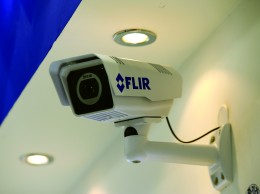A pair of entrepreneurs who built up and then sold Goleta-based Indigo Systems to Flir Systems are back in action with $20 million in fresh capital and a plan to commercialize military technology.
Bill Parrish and Tim Fitzgibbons have founded Tyrian Systems. Tyrian has negotiated a deal with Raytheon Vision Systems to package its technology for commercial markets.
“Raytheon has really pushed the state of the art,” Bob Johnson, Tyrian’s chief financial officer, told the Business Times. “If we can bring down the cost, we really think we can open the industrial market.”
A Raytheon spokeswoman confirmed the collaboration. Raytheon Vision Systems recently won a sole-source contract with the U.S. Army to build infrared rifle scopes in Goleta. That contract is expected to boost hiring at the 800-employee firm, which employs about 400 engineers, about 160 of which have advanced degrees, according to a Raytheon spokeswoman.
Parrish, Jim Knight and several other entrepreneurs founded Amber Engineering in 1983. The company pioneered applying commercial semiconductor technology to what until then had been a complex a complex process for building cooled thermal imagers.
With its detector chip and imaging assemblies, Amber introduced a series of infrared cameras for commercial and military markets that dramatically lowered prices.
Amber was sold to Santa Barbara Research Center in 1992. Amber’s read-out-integrated-circuit and detector technologies remain part of the genes of Raytheon Vision Systems and other Goleta infrared companies to this day.
In the late 1990s, Parrish and a small band of entrepreneurs started Indigo in Goleta to further exploit advances in “cooled” infrared technology and to develop products using “uncooled microbolometers,” which could reduce the size and price of cameras even further.
“Every camera had a little refrigerator on it. That was bulky and expensive,” Johnson said.
In 1999, Indigo hired Fitzgibbons from Rockwell’s Electro Optical Center to become Indigo’s CEO. Together, Parrish and Fitzgibbons led the Indigo team to introduce a variety of cooled and uncooled products, all based on detectors and assemblies manufactured at its facility in Goleta.
Indigo was sold to Flir Systems of Oregon in 2004 for $185 million. By the time of the acquisition, Indigo had attracted significant investment capital from the Carlyle Group, a variety of angel investors and had awarded incentive shares to most employees. Today, Flir in Goleta has approximately 440 employees. Parrish and Fitzgibbons left Indigo in 2006 to start another company in the thermal vision space.
But then the lawsuits struck. Parrish and Fitzgibbons had begun talks with Raytheon about starting a new company. The Oregon company sued them and alleged that there was no way the two could start a new business without infringing on trade secrets and intellectual property that belonged to Flir.
In 2008, Santa Barbara Superior Court Judge James Brown handed down a stern decision that affirmed Parrish and Fitzgibbons’ right to start their new business, a decision which held on appeal. Parrish and Fitzgibbons in turn sued Flir for interference with their business plans. In 2011, Flir settled that suit by paying Parrish and Fitzgibbons $39 million in cash. (A separate court battle between Raytheon and Flir is ongoing.)
The $20 million investment round in the newly formed Tyrian is actually an angel funding round — that is, the money came from the founders and select backers, rather than a venture capital firm. It is likely the largest such round in the region this year. “We referred to them as archangels,” Johnson said.
In the 20 years since Parrish and Fitzgibbons sold Amber Engineering to Raytheon, the defense giant has pushed the limits of what portable infrared cameras can do. Raytheon now has a three megapixel camera, a barrier that was reached with visible light cameras long ago but has remained elusive for portable infrared cameras. Such cameras can detect more than just hot objects. They can also see substances that are invisible to the naked eye.
“Infrared can see natural gas when it’s leaking. There are lots of opportunities to deliver a system for the oil market,” Johnson said.
Johnson said that it’s too early to tell whether Tryian might become a large employer. He said it could be up to two years before systems are ready for the market at a price the company believes will be competitive.
“It’s going to take a while. It’s going to take a lot of engineering to make this something other than a $40,000 military camera,” Johnson said.






 Print
Print Email
Email

















